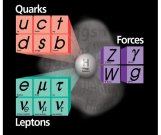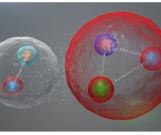The pentaquark mystery
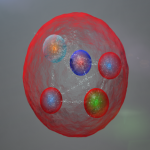
May 23, 2019 by olcyr
“If I could remember the names of these particles, I would have been a botanist.”
This quote is attributed to the physicist Enrico Fermi, Nobel laureate and one of the greatest minds of the XX century, expressing his perplexity about the large number of subatomic particles discovered in experiments in the late 50’s. The job of a physicist and a botanist are indeed very different: physicists are not only happy to know what nature is made of, but they also struggle to understand them in terms of a simple theory, which can describe their dynamics and make predictions that can be tested in experiments. Simplicity and beauty in terms of a mathematical theory are the main guidance of physics.
This quote might be misleading to the reader: While many particles have indeed been discovered in the past several decades, the vast majority of them are composed of smaller and more elementary particles. Elementary means that they cannot be broken into smaller pieces. Our understanding of this concept has evolved over time: from molecules to atoms and, nowadays, to subatomic particles, thanks to the theoretical and experimental effort in experiments such as the LHC at CERN.
The list of known elementary particles turns out to be much smaller than the botanist catalogue: there are only seventeen of those, in contrast to the hundreds of thousand of registered species of plants. Particle physicists know not only this list by heart, but they also are able to explain how these particle talk to each other by using, in many cases, only pen and paper.
Matter (what comprises us, the stars and galaxies) is composed by two types of fundamental particles: quarks and leptons, as well as their antiparticles (i.e. identical particles, but with opposite charges). Leptons comprise the electron and its cousins, the muon and tau, as well as the elusive neutrinos. Quarks, on the other hand, are the basic elements inside protons, neutrons and the vast plethora of particles known as hadrons to which Fermi referred to. The other known elementary particles are force carriers, which we will talk about in a second. Physicists have also very strong reasons to believe that there are unknown elementary particles still to be discovered, such as the evidence of neutrino oscillation and dark matter, which we will not have time to discuss today (see Ref. [4] for an outreach text on these issues).
What glues protons and neutrons together?
There are six quarks in nature, sometimes with funny names: up, down, strange, charm, beauty and top. The lightest of these are the up and down-quarks, with electric charges +2/3 and -1/3, respectively, while electrons have a charge -1. A proton is made of two up quarks and one down quark (p=uud), having then a positive charge, while a neutron is made of one up quarks and two down quarks (n=udd), being therefore neutral. These particles are combined in the nucleus of atoms. A natural question then arises: How can protons with the same electric charge be held together inside atomic nuclei?
The answer to this question comes from the other elementary particles we know: the force carriers, see Fig. 1. Quarks and leptons talk to each other via the exchange of virtual particles. These are the photon, which carries the usual electromagnetic interaction (light), the so-called W and Z for the electroweak (nuclear) force, and gluons that carry the strong force [1]. The strong force is precisely what glues nuclei together, overcoming the electromagnetic repulsion of protons. This fundamental interaction is so strong that it is responsible for most of the proton mass — the proton is actually much heavier than the sum of its constituents (quark) masses!
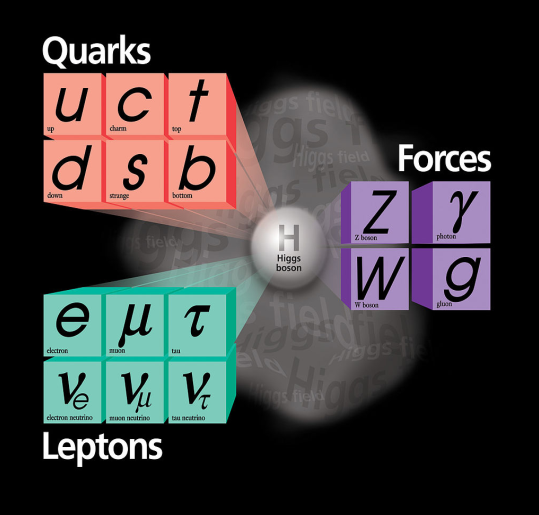 Fig. 1: Elementary particles known in nature. Matter is composed of quarks and leptons, which interact with each other via three fundamental forces: the electromagnetism, and the strong and electroweak interactions, which are associated to the photon, gluons, and the W and Z bosons. The theory describing these interactions is called the Standard Model (SM). The last missing piece of the SM is the Higgs boson, which was predicted in the 60’s and discovered at the LHC in 2012. There are several reasons to be believe that this picture is not complete, such as the evidence of neutrino oscillation and dark matter [Wikimedia Commons]
Fig. 1: Elementary particles known in nature. Matter is composed of quarks and leptons, which interact with each other via three fundamental forces: the electromagnetism, and the strong and electroweak interactions, which are associated to the photon, gluons, and the W and Z bosons. The theory describing these interactions is called the Standard Model (SM). The last missing piece of the SM is the Higgs boson, which was predicted in the 60’s and discovered at the LHC in 2012. There are several reasons to be believe that this picture is not complete, such as the evidence of neutrino oscillation and dark matter [Wikimedia Commons]
What is very puzzling about quarks is that they do not exist isolated in nature — they always bound together to form hadrons, such as protons and neutrons, making a large part of our known universe. For a long time, the only hadrons seen in nature were made of three quarks, or a pair of a quark and an anti- quark, as the ones Enrico Fermi talked about. Recent observations at LHC suggest that there are even more complicated objects out there in nature: tetraquarks and pentaquarks.
The observation of tetra and pentaquarks
The idea of having particles made by more than three quarks was first proposed in the theoretical works of Murray Gell-Mann and George Zweig in 1964. It took, however, more than 50 years to observe these states experimentally. The first evidence of these exotic particles came from the Belle experiment in Japan in 2012, indicating the existence of a tetraquark state [2]. In the following years, experimental searches performed at Stanford and Fermilab (USA), BES-III (China) and the LHC (CERN) have also observed similar states [3]. The first observation of pentaquark states came from the LHCb experiment in 2015.
What makes the observation of these particle so difficult is that they are very rare and very unstable — as soon as these particles are produced, they decay into lighter particles. For that reason, it takes a great deal of experimental precision to observe them. In practice, what we observe is precisely their decay products and their existence is inferred by reconstructing the decay chain. The very last piece of experimental information came early this year at the annual conference “Rencontres de Moriond”, where the LHCb collaboration presented new observed pentaquark states and raised further questions on the pentaquark identity [4].
A new particle or a molecule?
It is still too early to tell... The key question behind these striking experimental evidences is “what is the fundamental structure inside pentaquarks?”. Are they a new hadronic particle, made of tightly bound five quarks? Or, are they a combination of two loosely bound hadrons, containing two and three quarks each, and forming together a hadronic molecule? Recent LHCb results seem to suggest the second possibility, but more data is needed to fully disentangle these two possibilities.
Experimentalists working at LHCb are now performing a more refined analysis to pin-down other properties of these particles, such as their spin and parity. This information would help theorists to better understand the strong interactions and the internal structures of these particles, or perhaps more! The pentaquark mystery might be just a tip of an iceberg.
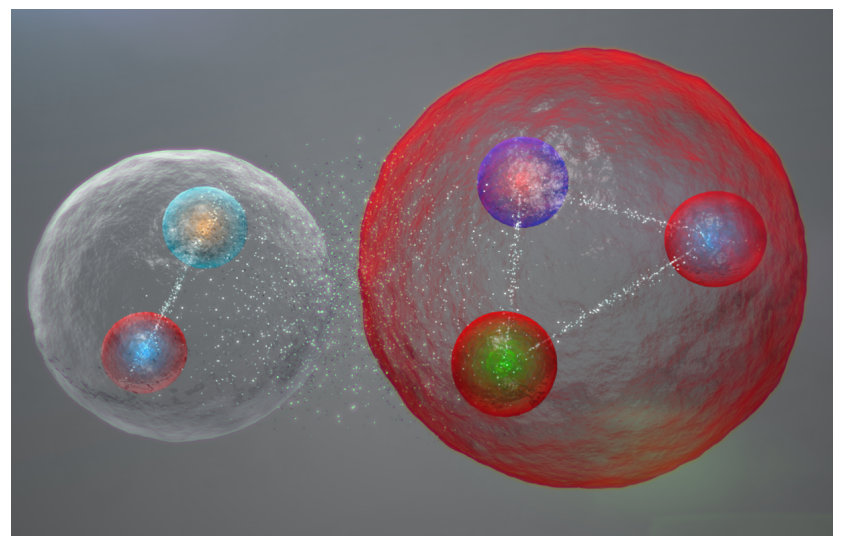
Fig. 2. A possible explanation of the structure of pentaquarks: two hadrons, one made of two quarks and one made of three quarks, which form together a subatomic molecule. [4]
References
[1] This whole picture can only be made coherent thanks to the existence of a last particle: the Higgs boson, also known as the god(less!) particle, which was hypothesized in the 60’ and discovered in 2012 at the LHC.
[2] “Problems in the standard model: a journey beyond it!”, Andrea Caputo.
http://www.elusives.eu/outreach/entry/problems-standard-model-journey-beyond-it
[3] “Observation of a Narrow Charmoniumlike State in B -> Kpi pi J/Psi Exclusive Decays”, S.-K. Choi et al. (Belle Collaboration). Phys. Rev. Lett. 91, 262001 (2003).
[4] CERN Press release, “CERN’s LHCb experiment reports observation of exotic pentaquark particles”.
https://home.cern/news/press-release/cern/cerns-lhcb-experiment-reports-observation-exotic-pentaquark-particles
[5] CERN Press release, “LHCb experiment discovers a new pentaquark”.
https://home.cern/news/news/physics/lhcb-experiment-discovers-new-pentaquark
-
Did you know that the name "quark" was first used by Murray Gell-Mann, inspired by a James Joyce's book?
The word quark itself denotes in english a dairy product. This term was first u...

